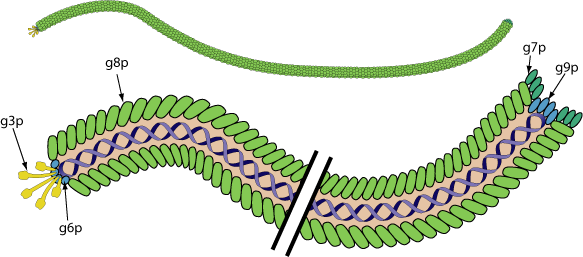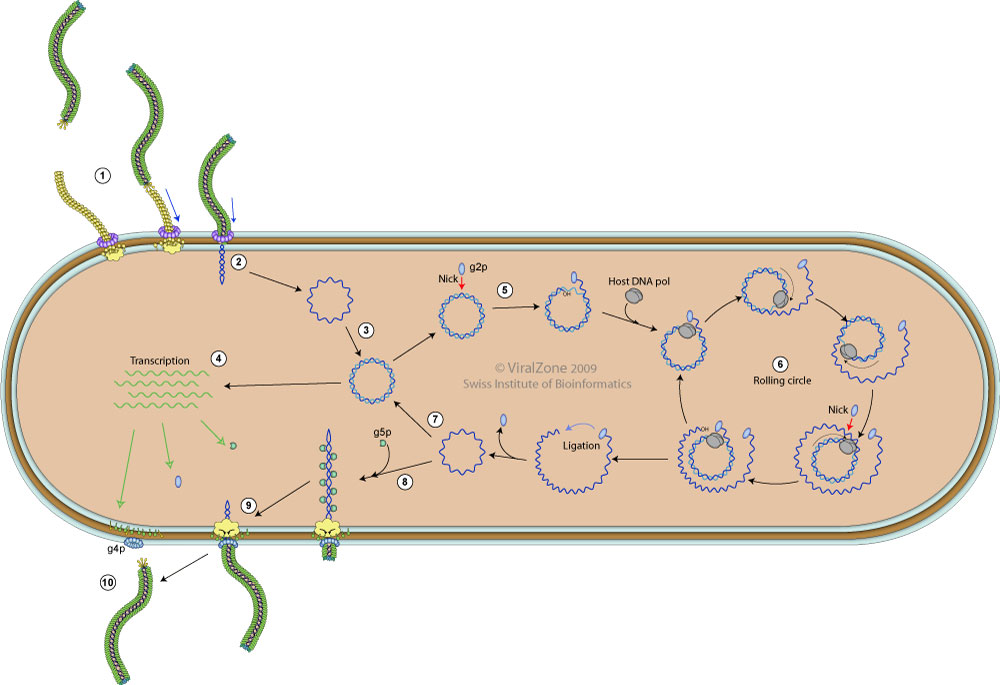Inoviridae (taxid:10860)
VIRION

Non-enveloped, rod of filaments of 7nm in diameter and 700 to 2000nm in length. Helical capsid with adsorption proteins on one end.
GENOME
Circular, ssDNA genome (+) of 4.5 to 8kb encoding for 4 to 10 proteins. Replication occurs via dsDNA intermediate and rolling circle.
GENE EXPRESSION
Each gene is transcribed by host cellular machinery, via a specific promoter. Some genes end by a transcription terminator.
ENZYMES
REPLICATION
CYTOPLASMIC
- Viral g3p protein mediates pilus-mediated adsorption of the virus onto host cell. Pilus retraction pulls the virion to the host internal membrane.
- The proteins of the capsid perform the injection of the viral DNA through bacterial membranes into cell cytoplasm.
- Host polymerase convert the (+)ssDNA viral genome into a covalently closed dsDNA called replicative form DNA (RF).
- dsDNA transcription by host RNA polymerase gives rise to viral mRNAs.
- Viral g2p protein nicks RF DNA strand at the origin of replication.
- (+) strand replication occurs by rolling circle.
- New (+)ssDNA genomes are converted into new RF molecules, and further transcription occurs.
- When enough g5p protein is synthesized, conversion into RF dsDNA is inhibited, as neo-synthesized genomic ssDNA is covered with g5p.
- g5p are replaced by g8p proteins to trigger the assembly of the viral capsid.
- New virions are secreted from host cell.
- Infected cells continue to divide and produce virions indefinitely.
replication cycle

- Viral g3p protein mediates pilus-mediated adsorption of the virus onto host cell. Pilus retraction pulls the virion to the host internal membrane.
- The proteins of the capsid mediate the Injection of the viral DNA through bacterial membranes into cell cytoplasm.
- Host polymerase convert the (+)ssDNA viral genome into a covalently closed dsDNA called replicative form DNA (RF).
- dsDNA transcription by host RNA polymerase gives rise to viral mRNAs.
- Viral g2p protein nicks RF DNA strand at the origin of replication.
- (+) strand replication occurs by rolling circle.
- New (+)ssDNA genomes are converted into new RF molecules, and further transcription occurs.
- When enough g5p protein is synthesized, conversion into RF dsDNA is inhibited, as neo-synthesized genomic ssDNA is covered with g5p.
- g5p are replaced by g8p proteins to trigger the assembly of the viral capsid.
- New virions are secreted from host cell.
- Infected cells continue to divide and produce virions indefinitely.
Matching UniProtKB/Swiss-Prot entries
(all links/actions below point to uniprot.org website)87 entries grouped by protein
12 entries
Capsid protein G8P (Coat protein B) (Gene 8 protein) (G8P) (Major coat protein)
7 entries
Gene 1 protein (G1P)
9 entries
Attachment protein G3P (Gene 3 protein) (G3P) (Minor coat protein)
6 entries
Virion export protein (Gene 4 protein) (G4P)
9 entries
DNA-Binding protein G5P (G5P) (GPV) (Single-stranded DNA-binding protein)
8 entries
Head virion protein G6P (Coat protein D) (G6P)
7 entries
Tail virion protein G7P (Coat protein C, polypeptide I) (Gene 7 protein) (G7P)
7 entries
Tail virion protein G9P (Coat protein C, polypeptide II) (G9P)
1 entry
Putative integrase
8 entries
Replication-associated protein G2P (Rep) (EC 3.1.21.-) (EC 6.5.1.1) (G2P) (Gene 2 protein)
1 entry
3.2 kDa protein (ORF 30)
1 entry
6.4 kDa protein (ORF 58)
2 entries
7.9 kDa protein (ORF 71)
1 entry
Uncharacterized protein ORF83 (ORF083)
1 entry
10.1 kDa protein (ORF 90)
1 entry
10.9 kDa protein (ORF 96)
1 entry
11.2 kDa protein (ORF 103)
1 entry
12.0 kDa protein (ORF 110)
1 entry
Putative assembly protein ORF301 (ORF301)
1 entry
Uncharacterized protein ORF424 (ORF 424)
2 entries
